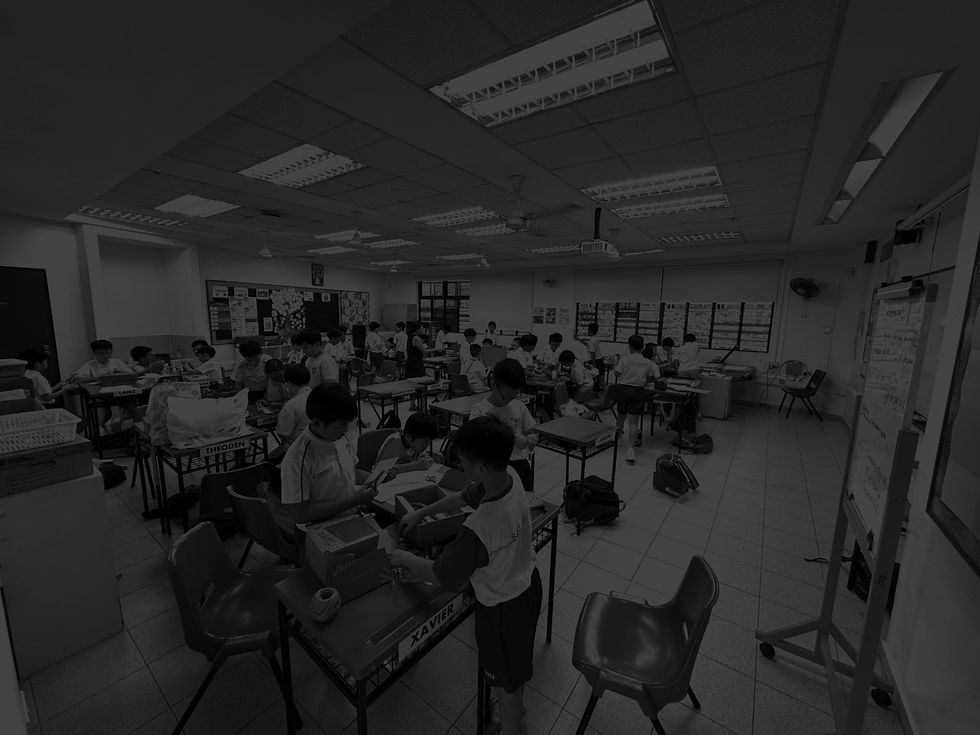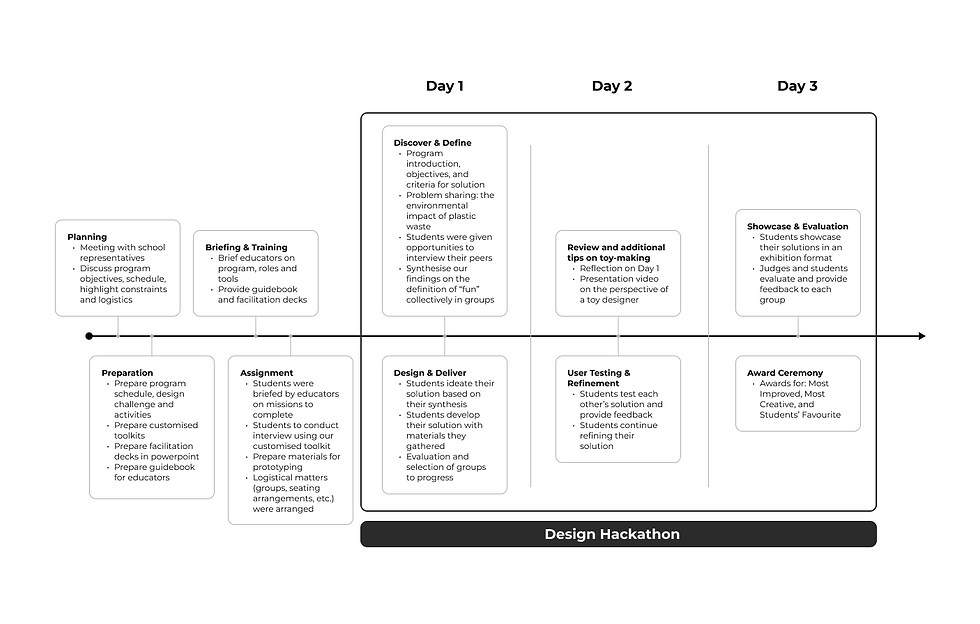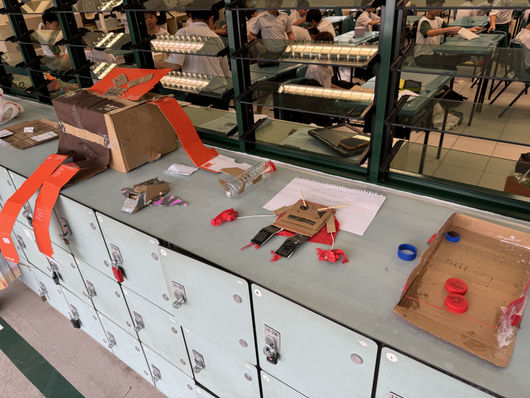
Learning
By
Design
.png)
Client
St. Joseph's Institution Junior
Date & Duration
Jan 2024 - Jul 2024 / 7 months
My Contributions
Project Leader; Project Management; Curriculum Design; Lesson Planning; Facilitation; Toolkit Design and Development;
in collaboration with Brian Ling and Tan Ying Hui.
Project
Summary

At St. Joseph's Institution Junior, a Design Hackathon was designed, developed, and facilitated for Primary 5 students under the Learning By Design initiative. The event introduced students to Design Thinking principles and provided a hands-on experience where real-world problems were identified and creative solutions were brainstormed.
PROJECT TIMELINE

PLANNING
& CONSIDERATIONS
The goal of St. Joseph's Institution Junior (SJIJ) was to provide all (240) Primary 5 students with an immersive experience in Design Thinking through a comprehensive 3-day program. The 3-day program aimed to guide students through key stages: Discover, Define, Design, and Deliver.
Student Profile and Learning Needs
-
SJIJ is an all-boys school, requiring us to consider how to tailor activities to engage and channel the energy of 11-year-olds (Primary 5 students).
-
To sustain their interest, the high levels of enthusiasm typical of this age group needed to be matched with hands-on, engaging activities.
-
The approach had to ensure Design Thinking was made relatable and fun, using examples and exercises that resonated with the students' everyday experiences.
-
Activities need to be structured to accommodate the number of students, varied levels of understanding, and cognitive development among the students.
School Restrictions and Logistics
-
Managing logistics for 240 students on Day 1, including organising materials for prototyping and creating a structured environment for hands-on activities.
-
Ensuring that educators with little to no prior understanding of design thinking could effectively contribute as co-facilitators, providing them with simplified guides.
-
Structuring the program so that only selected 60 students could continue on Days 2 and 3, which required careful planning to maintain momentum and engagement for the remaining students.
-
Rotating co-facilitators meant designing activities that allow for a seamless transition between educators, minimising disruptions in the students' learning experience.
Types of solutions:

DELIVERY
A competition-style 3-day Design Hackathon was conceptualised to engage all 240 Primary 5 students in the Design Thinking process. On Day 1, all students participated in the Discover, Define, Design, and Delivery phases. During the Discover phase, students conducted interviews to gather insights. In the Define phase, they synthesised their findings to pinpoint core problems. The Design phase involved brainstorming creative solutions, and the Delivery phase allowed them to develop initial prototypes. On Days 2 and 3, a selected group of 60 students continued to refine their prototypes, working collaboratively to enhance their ideas.

The students were presented with the exciting challenge of designing toys and games. By tapping into their enthusiasm for play, students were not only motivated to actively participate in the Design Thinking process but also engaged in generating creative ideas and innovative solutions.
Prior to the hackathon, we laid the groundwork to ensure a smooth and effective experience for both students and educators. We began by conducting a teacher-training session to equip educators with the knowledge and tools needed to support the students. During this session, educators were provided with a comprehensive guidebook outlining the entire Design Thinking process, along with clearly defined roles and responsibilities. The guidebook also included an overview of the specific activities planned for the workshop.
To prepare the students, we distributed a pre-hackathon mission handout to their respective teachers. This handout contained detailed instructions for completing essential tasks ahead of the hackathon, such as conducting user interviews using our custom-designed toolkit, gathering materials for prototyping, and a video study to inspire students about toy-making.
OUTCOME
We specially designed the tasks given to the students to be relatable, engaging, and structured to capture their interest and maintain their attention throughout the process. Additionally, clear instructions and guidance through the use of toolkits and presentation slides ensuring students understood each step of the process.
Given the young age and large number of participants, detailed guidance and well-organised facilitation were crucial for maintaining engagement and effectively managing the group. However, during the ideation and prototyping phases, students were given the freedom to explore independently, allowing their creativity and enthusiasm to shine. This intentional balance between structured support and autonomy enabled students to develop critical thinking, problem-solving, and creativity skills without restraint.



Among the 19 projects overseen, one fell short of meeting the KPI requirements, encompassing productivity gains (minimum 30%), return on investment (within 3.5 years), and user satisfaction (more than 80% satisfaction). This outcome was anticipated upon assuming responsibility for the project, given the vendor's inadequate service and product delivery to the SSA. Despite concerted efforts and interventions from both our team and NCSS, the vendor's improvements failed to align with the project's specifications. Moreover, the vendor encountered challenges in sustaining their project team, resulting in frequent personnel changes that led to project delays, knowledge gaps, and insufficient handover processes.
Incorporating fun into the Design Thinking process created an environment that encouraged students to explore, experiment, and embrace the uncertainties inherent in creativity and innovation. This approach not only made the experience enjoyable but also enriched their understanding and strengthened their problem-solving skills.
%20(15).png)
From our learnings mentioned above, it became evident to us that majority of our users fall between the "Awareness" & "Consideration" phases of the customer funnel - the marketing term that shows the potential customer's journey toward the purchase of a good or service. With this model in mind, we also take into consideration the other phases as well to ensure the sustainability of the microsite.
"Awareness" :
The initial stage whereby the customer / user finds the brand, product or service appealing. This is the start to making them receptive to future interactions.
"Consideration" :
Users are in careful thought, whether or not to proceed with the brand, product or service in comparison with other providers / competitors.

GOING FORWARD
Future opportunities
-
The questionnaire could be further developed with more extensive research to determine more accurate allocations for the users to determine the stages of career development they should focus on.
-
We proposed to Doerscircle how the microsite could be integrated into the main site and existing CRM to avoid confusion for users to navigate two different sites at the same time integrating the proposed microsite into the existing user's portal (from the main site).
-
As this is a concept design, Doerscircle could still adopt the designed solutions into their main website.
Check out
my other works
MCCY
Bringing community and organisations together through arts, sports and community involvement.

Coming Soon
ActionCity
Taking a physical in-store experience into a digital platform.
THANK YOU FOR READING!





















_gif.gif)